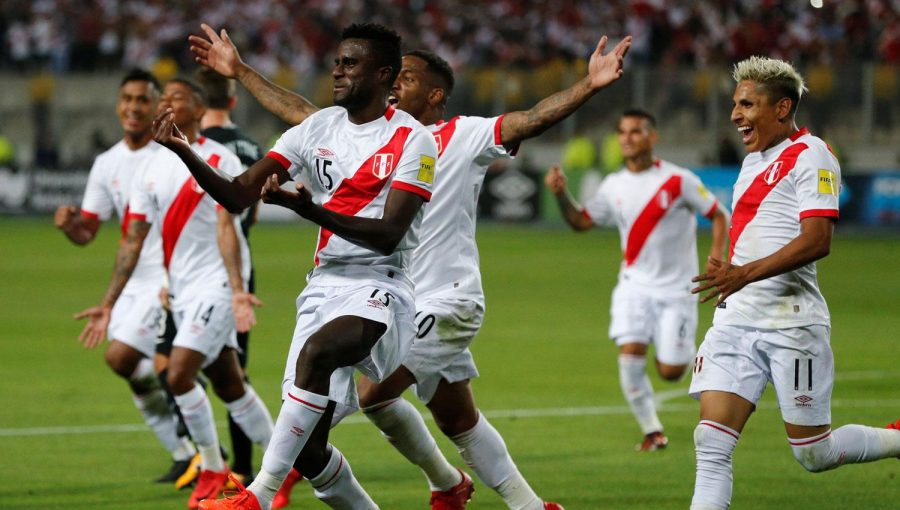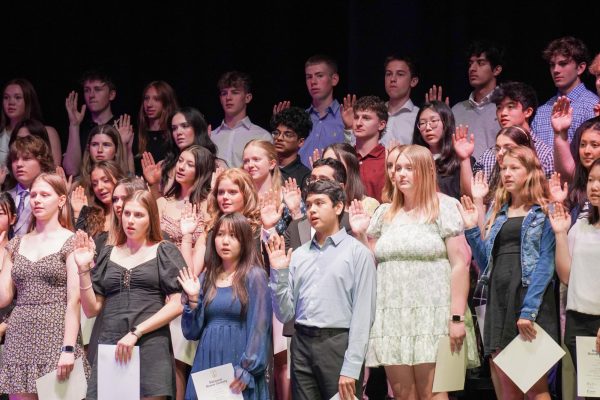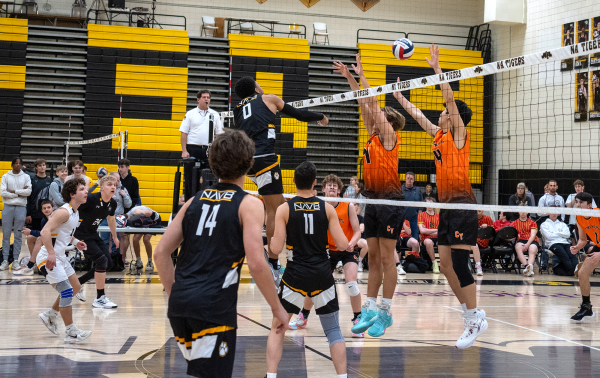2018 World Cup Qualifiers Recap
Christian Ramos and the Peru national football team celebrate, seconds after qualifying for their first World Cup since 1982.
December 7, 2017
Lima, the 15th of November, 2017. Public holiday has been declared, people are parading in the streets, fireworks erupt throughout the city, earthquake alerts have been sent off.
Why? For the first time in 36 years, Peru has qualified for the 2018 World Cup Finals in Russia. The Peruvians are the last team to qualify and will join 31 other nations for the biggest event recurring every four years.
The journey to qualify started on December 10, 2010. When the Russians became the host nation, they also received the privilege of skipping the qualification process. For the other 31 spots, qualifiers began almost immediately after the conclusion of each continent’s respective international tournament in 2016. Over the course of the next year and a half, 20 teams found themselves returning to the the biggest stage of international football, 10 found themselves returning after missing a World Cup, and Iceland and Panama qualified for their very first World Cup appearance.
Biggest Winners
Iceland: Topping Group I in the UEFA qualifying group was no easy task for a country with a population the size of Pittsburgh, but the Strákarnir Okkar managed to do so by beating Croatia, Ukraine, and Turkey, countries many times bigger with far more prestigious soccer histories. Gylfi Sigurðsson led the charge with four goals, but by all means the feat was a team accomplishment throughout all levels of Icelandic football. The stellar qualification is the crown jewel of the evolution of Icelandic football, which also includes a recent top-8 performance in the 2016 Euros and a victory over England.
Egypt: Mohamed Salah and his teammates finally beat the curse of not being able to qualify for the World Cup, despite being one of the best teams in Africa and having won AFCON five times since their previous qualification in 1990. Salah recorded five out of their eight goals in the campaign to make it to Russia, including two vital goals in the final game against the Republic of the Congo.
Serbia: After bombing out of the 2016 Euro qualifiers in a flash of both on and off the pitch controversy, a World Cup Qualifying group including Austria, Wales, and Ireland was bound to be no small task. Regardless, the Serbs managed to pull out win after win and qualify top of their group.
Panama: Joining Iceland as newcomers to the World Cup Qualifiers, Panama was pulverized 6-0 by the Americans but still managed finish above them and automatically qualified for the World Cup in CONCACAF’s multi-stage Hexagonal procedure.
Peru: The mighty Peruvians faced no lack of hardship in their qualification for the World Cup. After drawing their final game to Columbia and being forced to play a set of playoff games against Oceania champions New Zealand, Peru temporarily shut down their domestic league to ensure players would be prepared to qualify for the World Cup. A tense 0-0 draw in Auckland meant that the Peruvians needed a home win to qualify. The 2-0 win did exactly that and filled the final spot for the upcoming Russian World Cup Finals.
Biggest Losers
United States of America: In a spectacular performance, the USMNT managed to miss qualifying for Russia in a day that went wrong in every possible way. Going into the last day of qualifying, all the Americans had to do was beat the already eliminated island nation of Trinidad and Tobago to clinch their spot. Even if this effort failed, both Mexico and Costa Rica had to lose to Honduras and Panama, respectively. As rain soaked the pitch in Trinidad and Tobago and led to a lethargic loss against a nation of only 1.3 million inhabitants, balls were soaring into the backs of already-qualified Mexican and Costa Rican nets. Everything that could’ve gone wrong did, and the United States of America failed to qualify for the first time since 1990.
Netherlands: One of the most tragic stories in international football has been the demise of the Orange Powerhouse since the 2014 World Cup. The Dutch quickly went from 3rd place in Brazil to missing out of the 2016 Euros and then failing to qualify for the 2018 World Cup. The rapid decline has been blamed on many factors including bad coaching, aging players, and bad luck; however, the truth of the matter lies with entitled expectations of qualification and a failure to challenge themselves. In a moment of irony, Dick Advocaat, the former Dutch coach during the qualifiers, proclaimed the Dutch would almost definitely qualify as there was no way that Sweden could overcome their goal differential deficit by beating Luxembourg 8-0 only days before Sweden managed to, in fact, beat Luxembourg 8-0 and qualify in place of the Netherlands.
Italy: Four time World Cup winners are almost always expected to qualify and this was certainly true in the case of the Italians, who had qualified for every World Cup since 1958 and had even booked flights and entire floors of hotels they would be staying at when they were to qualify for Russia. Gian Piero Ventura is largely to blame for failing to qualify, as he quite stubbornly refused to adjust his tactics against Sweden in the UEFA playoff stages for teams who had been second in their qualifying groups. The loss triggered tears among the Italian players as the final whistle rang defeat. Italian legends such as Gianluigi Buffon, Daniele De Rossia, Giorgio Chiellini, Andrea Barzagli, all members of of the legendary squad that won the 2006 World Cup in Germany, announced their retirements from international football after two loyal decades and a combined 461 caps. Booking their hotels in advance only caused further embarrassment as Denmark contacted the Italian Football Agency in attempt to purchase their premature reservations.
Chile: Chile was once proclaimed as the only team to achieve full potential out of their “Golden Generation” of players including Alexis Sanchez, Arturo Vidal, Claudio Bravo, Eduardo Vargas, Gary Medel, and others by becoming back-to-back champions of the South American Copa América in 2015 and 2016. Chile even became the third ranked team in FIFA in spring of 2016 and were looking to be serious contenders for the upcoming World Cup Finals in Russia. Yet, in a remarkable span of 90 minutes, Chile went from being third in the Round Robin group stage to sixth and missed out one of the top five qualifying spots. Suffering a loss at the hands of Brazil meant they missed out on 3 points, and although Peru drew against Colombia and became even on a points basis a lower goal difference destroyed their Golden Generation’s chance to maximize potential.
Russia: UEFA (returning)
Brazil: CONMEBOL (returning)
Iran: AFC (returning)
Japan: AFC (returning)
South Korea: AFC (returning)
Saudi Arabia: AFC (Last Appearance: 2006)
Mexico: CONCACAF (returning)
Belgium: UEFA (returning)
Germany: UEFA (returning)
England: UEFA (returning)
Poland: UEFA (Last Appearance: 2006)
Costa Rica: CONCACAF (Returning)
Nigeria: CAF (returning)
Egypt: CAF (Last Appearance: 1990)
Iceland: UEFA (First Appearance)
Serbia: UEFA (Last Appearance: 2010)
Spain: UEFA (returning)
France: UEFA (returning)
Portugal: UEFA (returning)
Panama: CONCACAF (First Appearance)
Argentina: CONMEBOL (returning)
Uruguay: CONMEBOL (returning)
Colombia: CONMEBOL (returning)
Senegal: CAF (Last Appearance: 2002)
Morocco: CAF (Last Appearance: 1998)
Tunisia: CAF (Last Appearance: 2006)
Switzerland: UEFA (returning)
Croatia: UEFA (returning)
Sweden: UEFA (Last Appearance: 2006)
Denmark: UEFA (Last Appearance: 2010)
Australia: AFC (returning)
Peru: CONMEBOL (Last Appearance: 1982)
Check out our parallel article for more on the World Cup.













